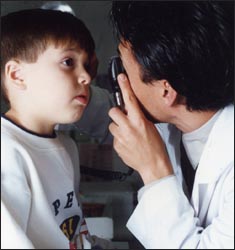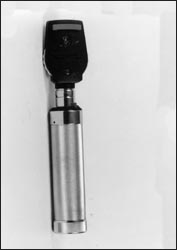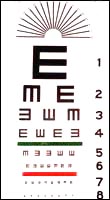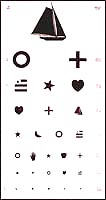시력 검사, Vision test(Eyesight test)
신생아 시력검사, 영유아 시력검사, 3세나 그 이상 유아 학령기 아이들, 사춘기 아이들 시력검사, 소아들 시력검사
시각 발육 Visual sensation development
- 시각의 3가지의 주요 1차적 기능은
-
- 빛 인지,
- 색 분별,
- 영상의 크기와 모양 인지이다.
- 영상의 크기와 모양에 관한 시각은 형태시각이라고 한다. 이런 형태시각은 생후 3개월까지 시각피질(후두피질)에서 형성된다.
- 망막에 있는 황반 중심와는 생후 6세까지 성장이 완료되고 이 향반 중심와는 색각(Color vision)을 인지하는 기능을 갖고 있다.
- 생후 바로 신생아의 시각기능이 있다.
- 생후 36시부터 얼굴표정을 분별할 수 있고 모방할 수 있다.
- 7개월 된 태아도 신생아도 명암의 빛을 인지 할 수 있다.
- 생후 3~5개월부터 적, 황, 록, 청색을 인지할 수 있다.
- 1세까지 정시안 시력은 20/20이다. 출처 : Growth development p236-238
- 영아 시력검사 시스템(Infant pediatric vision testing system)이나 피디비지오 SO4 시각 스크린(PediVisio SO4 vision screen)검사로 영유아들의 시력을 검사할 수 있다.
- 일생 동안 건강한 눈과 정상 시력을 갖기 위해 태어나서부터 성인으로 성장될 때까지, 그리고 성인이 된 이후 눈과 시력을 단골 의사나 안과 전문의로부터 정기적으로 검사 받고 시력과 눈에 생긴 어떤 이상은 조기에 적절히 진단 치료를 받아야 한다.
- 바로 이런 최고로 좋은 눈 건강 유지 방법이 건강한 눈과 좋은 시력을 일생 동안 계속 갖고 살 수 있는 최상 비결 중 하나이다.
- 부모는 성장하는 어린 자녀의 눈과 시력이 정상인지 평소 잘 관찰해야 한다.
- 부모도 반의사가 되어야 한다-제 3권 신생아, 영유아, 학령기 아이 사춘기 아이 성장발육-성장발육 이정표를 통해 나이에 따라 무엇이 정상 시력인지 정상 성장발육인지 알아보고, 자녀의 시력이 정상인가 아닌가를 간접적으로 알아볼 수 있다.
- 예를 들면, 생후 2개월 대부분의 영아들은 엄마 아빠의 얼굴을 쳐다보고 방실방실 웃기 시작한다.
- 생후 4개월 대부분의 영아들은 눈 가까이에서 장난감 등 작은 물체가 이동하고 있는 방향에 따라 얼굴을 돌릴 수 있고, 그 장난감을 쳐다볼 수 안다.
- 생후 9∼12개월 영아들의 대부분은 방바닥에 떨어진 콩알, 또는 그 것보다 훨씬 작은 것을 보고 손가락으로 집을 수 있다. 부모도 반의사가 되어야 한다-제 3권 신생아, 영유아, 학령기 아이 사춘기 아이 성장발육-생후 29일에서 2개월까지 성장 발육의 사회성, 생후 4개월에서 6개월까지 성장 발육의 사회성 참조.
- 이상 설명한 시력 성장 발육 이정표보다 시력 발육이 부진하고 시력 이상이 있다고 의심하거나, 영유아가 무엇을 잘 볼 수 없다고 생각하면 서슴지 말고 의사에게 문의해 눈과 시력을 검사해야 한다.
- 생후 2~3세부터 유치원에 들어가기 전에 소아 건강검진을 단골 소아청소년과 의사로부터 받을 때마다 영유아들의 눈과 시력을 검사받아야 한다.
- 영유아들의 나이와 성숙도에 따라 여러 가지 방법으로 집에서든지 소아청소년과에서 눈과 시력을 검사할 수 있다.
- 일반적으로, 3세 이후부터 유치원에 들어가기 전에 타들러 유아들의 시력을 검사할 때는 유치원 아동용 시력검사 표(사진42)를 이용한다.

그림 41. 신생아들도 영유아들도 학령기, 사춘기 아이들도 성인들도 눈과 시력검사를 정기적으로 받아야 한다.
Copyright ⓒ 2011 John Sangwon Lee, M.D., FAAP

그림 45. 눈 검사할 때 쓰는 안검경
Copyright ⓒ 2011 John Sangwon Lee, M.D., FAAP

그림 44. 시력검사에 쓰는 시력 검사표
Copyright ⓒ 2011 John Sangwon Lee, M.D., FAAP

그림 43. 소아들이나 성인들의 시력을 검사할 수 있는 시력 검사 표
Copyright ⓒ 2011 John Sangwon Lee, M.D., FAAP

그림 42. 3세나 그 이상 유아들의 시력을 검사할 수 있는 시력 검사표
Copyright ⓒ 2011 John Sangwon Lee, M.D., FAAP
- 3세 이후부터 E 시력검사 표를 이용할 수 있다.
- 알파벳을 알면 알파벳 시력검사표로 시력을 검사할 수 있다.
- 적어도 1년에 한 번 학교에서나 소아청소년과에서, 클리닉, 또는 병원에서 학령기 아이들과 사춘기 아이들의 눈과 시력을 정기적으로 검사받아야 한다.
- 2∼6세 유아들의 일부는 눈과 시력을 검사 받는 것을 두려워한다. 어떤 유아들은 시력검사표로 시력검사를 받을 때 시력 검사를 하는 사람이 무엇을 어떻게 하라고 지시하고 요구하는지 확실히 몰라 실제 시력은 정상인데 훨씬 낮은 비정상 시력이 있다고 진단 붙일 수 있다.
- 심지어 어떤 유아들은 시력검사를 하는데 전혀 협조하지 않아 시력검사를 제대로 할 수 없는 경우도 있다.
- 영유아들이, 특히 유아들이 소아청소년과에서나 클리닉 또는 병원에서 시력검사를 받기 전에, 부모가 집에서 시력검사표로 시력검사를 하는 방법에 관해서 집에서 연습을 하고 그 유아 자녀에게 잘 설명하면 차후 소아청소년과에서나 병원에서 보다 쉽게 유아 시력검사를 할 수 있다.
- 때로는 가정용 E 시력검사표를 이용해 부모가 집에서 자녀들의 시력을 정식으로 검사할 수 있다.
시력검사를 꼭 받아야 할 경우
- 눈이나 시력에 어떤 이상이 있는 경우
- 책이나 물체를 눈 가까이 갔다대고 보거나 읽거나, 너무 멀리 떼 놓고 보거나 읽는 경우
- 무엇을 볼 때 눈살을 찌푸리는 경우
- 친 부모 형제자매들 중 근시나 원시, 또는 난시 등 굴절 시력장애가 있는 경우
- 학교 성적이 뚜렷한 이유 없이 계속 떨어지는 경우
- 사시가 있거나 사시가 있다고 의심되는 경우
- 유치원, 초중고교 입학을 하기 바로 전 시력검사를 받고 이미 안경을 쓰고 있는 학령기 아이들은 시력검사를 필요에 따라 수시 받아야 한다.
- TV를 보기 전에는 안경을 쓰고 있던 아이가 TV를 볼 때는 안경을 벗는 경우
- 그 밖에 아이의 시력이나 눈에 어떤 이상이 있다고 생각될 때.
3세나 그 이상 유아들이나 학령기 아이들의 시력을 집에서 검사하는 법
- 유아들이나 하령기 아이들의 시력을 가정에서 부모가 검사할 수 있다.
- 이때 가정 시력 검사용 E 표를 이용할 수 있다 (가정 시력 검사용 E 표를 단골 소아청소년과 의사나 약국에서 구할 수도 있다).
가정 시력 검사하는 방법
- “손가락으로 가리키는 게임을 하자”고 말하고 E자가 뚫린 방향을 검사 받는 아이의 손가락이나 손으로 가리키게 한다.
- 검사를 하기 전 검사하는 부모와 검사 받는 아이가 앉아서 연습을 먼저 한다.
- 아이가 E시력 검사 표에 있는 E자가 위로, 아래로, 좌로 또는 우로 열린 방향을 가리킬 수 있으면 그 아이의 시력을 측정한다.
- 빈 컵처럼 오므린 부모의 한 손으로 검사 받는 자녀의 한 눈을 가린다.
- 이때 눈을 눌러서는 안 된다.
- E자를 잘 볼 수 있게 실내를 밝게 한다.
- 제일 큰 E자부터 검사한다.
- 제일 작은 E자도 검사한다.
- 옳게 본 E자에 해당되는 시력 검사치를 기록한다.
- 검사 받는 아이가 피로한 것 같거나 협조하지 않으면 다른 날 다시 검사한다.
- 이 검사에서 3~4세 유아는 20/40 시력 검사치를 볼 수 있고 5세 유아는 20/30 시력 검사치를 볼 수 있다.
- 5세 이상 학령기 아이들은 20/20 시력 검사치를 볼 수 있다.
- 여러 번 검사한 시력 검사치의 결과가 정상 시력검사치보다 낮으면 의사의 재검사를 받아야 한다.
|
나이에 따른 소아청소년(0~18세) 정상 시력
|
Vision test (Eyesight test)
Newborn eye exam, infant eye exam, school-age children 3 years and older, adolescent eye exam, children eye exam
Visual sensation development
• The three main primary functions of vision are
• o light perception, o color discrimination;
o Recognition of image size and shape.
• The perspective regarding the size and shape of an image is called shape vision. This type of vision is formed in the visual cortex (occipital cortex) until 3 months of age.
• The macular fovea in the retina is fully grown by the age of 6 years, and this fovea has the function of recognizing color vision.
• Newborns have visual function right after birth.
• From the age of 36, the child can identify and imitate facial expressions.
• Even a 7-month-old fetus and a newborn baby can perceive the light of light and darkness.
• From 3 to 5 months old, they can recognize red, yellow, green, and blue colors.
• By 1 year of age, the visual acuity is 20/20. Source: Growth development p236-238
• Infant pediatric vision testing system (Infant pediatric vision testing system) or PediVisio SO4 vision screen (PediVisio SO4 vision screen) to test the vision of infants and young children.
• To have healthy eyes and normal vision throughout life, from birth to adulthood, and after adulthood, have your eyes and vision checked regularly by a regular doctor or ophthalmologist, and any vision and eye abnormalities should be promptly and properly checked. You should get diagnostic treatment.
• This very best way to keep your eyes healthy is one of the best secrets to having healthy eyes and good eyesight for a lifetime. • Parents should closely monitor their growing young children’s eyes and vision to make sure they are normal.
• Parents Should Be Anti-Victims – Volume 3 Newborns, Infants, School-age Children Growth and Development of Adolescent Children – Find out what is normal vision and normal growth and development according to age through the growth and development milestones, and indirectly determine whether your child’s vision is normal or not. can find out
• For example, at 2 months of age, most infants look at their parents’ faces and begin to laugh.
• At 4 months of age, most infants are able to turn their faces and look at toys, such as small objects, in the direction they are moving near their eyes.
• Most infants 9-12 months old can see a pea, or much smaller, that falls on the floor and pick it up with their fingers. Parents should also be anti-doctors—See Book 3 Newborns, Infants, School-age Children, Adolescent Growth and Development—Sociality of Growth and Development from 29 days to 2 months of age, Sociality of Growth and Development from 4 to 6 months of age.
• If you suspect that your eyesight is developing slower than the above-described vision growth and development milestones, have vision abnormalities, or if you believe that your baby is not able to see well, do not hesitate to contact a doctor to have your eyes and vision checked.
• From the age of 2-3 years old, before entering kindergarten, the eyes and eyesight of infants and young children should be checked whenever they receive a health check-up from their regular pediatrician.
• Depending on the age and maturity level of infants and young children, there are several methods available for eye and vision examinations, either at home or at the Pediatric Department.
• In general, use the Kindergarten Eye Examination Table (Picture 42) when examining the eyesight of toddlers from 3 years of age before entering kindergarten.

Figure 41. Newborns and infants alike school-age, adolescents and adults should have regular eye and vision exams. Copyright ⓒ 2011 John Sangwon Lee, M.D., FAAP

Figure 45. Ophthalmoscope for eye examination Copyright ⓒ 2011 John Sangwon Lee, M.D., FAAP

Figure 44. Eye chart for eye exam Copyright ⓒ 2011 John Sangwon Lee, M.D., FAAP

Figure 43. Eye exam table to test the eyesight of children and adults Copyright ⓒ 2011 John Sangwon Lee, M.D., FAAP

Figure 42. Vision test chart for children aged 3 years and older Copyright ⓒ 2011 John Sangwon Lee, M.D., FAAP
• E-vision tables are available from age 3 onwards.
• If you know the alphabet, you can test your eyesight with the Alphabet Eye Chart.
• Get regular eye and vision examinations of school-aged and adolescent children at least once a year at school, pediatrics, clinics, or hospitals.
• Some 2-6-year-olds are afraid to have their eyes and vision checked. Some infants are not sure what to do and what to do when they have an eye exam using an eye chart, so they can diagnose that they have a much lower abnormal visual acuity, although their actual visual acuity is normal.
• Even some infants do not cooperate at all with the eye examination and may not be able to do the eye examination properly.
• Before young children, especially infants, have their eyes tested at a pediatric department or clinic or hospital, parents practice at home on how to do an eye exam using an eye chart at home, and explain to the young child well in the future. In a department or hospital, it is easier to do an infant vision test.
• Occasionally, parents can formally check their children’s eyesight at home using the Home E Vision Chart.
you must have an eye exam in followings
1. If you have any problems with your eyes or eyesight
2. If you look or read a book or object close to your eyes, or looking or reading a book or object too far away.
3. Frowning when looking at something
4. In case of refractive vision disorders such as nearsightedness, farsightedness, or astigmatism among the siblings of the biological parents 5. School grades continue to decline for no apparent reason
6. If you have strabismus or are suspected of having strabismus 7. School-age children who have undergone an eye exam just before entering kindergarten, elementary, middle, and high school and are already wearing glasses should receive eye exams as often as necessary.
8. When a child who was wearing glasses before watching TV takes them off while watching TV
9. When you think there is something else wrong with your child’s eyesight or eyes.
How to check the eyesight of children aged 3 years and older or school-age at home
• Parents can check the eyesight of infants and young children at home.
• At this time, you can use the E-ticket for home vision screening (you can also get the E-ticket for home vision screening at your regular pediatrician or pharmacy).
How to do a home vision test
• Say, “Let’s play a game of pointing with your finger,” and have your child’s finger or hand point in the direction of the hole in the letter E.
• Before the test, the test parent and the test child sit down and practice first.
• Measure your child’s vision if the letter E on the E-vision test table can point to an open direction up, down, left, or right. • Cover one eye of the child being tested with the parent’s hand, which is closed like an empty cup.
• Do not press on the eyes at this time.
• Brighten the room so you can see the letter E.
• Inspect the largest letter E first.
• Inspect even the smallest E.
• Record the vision test that corresponds to the correct letter E.
• If the child being tested seems tired or doesn’t cooperate, test again another day.
• On this test, a 3- to 4-year-old will take a 20/40 vision test and a 5-year-old will take a 20/30 vision test.
• School-age children 5 years and older can take the 20/20 vision test.
• If the results of multiple eye exams are lower than the normal eye exam values, you should see your doctor again.
Normal visual acuity in children and adolescents (0-18 years old) according to age
• Normal visual acuity for newborns is about 20/100.
• Normal visual acuity for children aged 3-4 years is 20/30.
• It is normal for children 5-6 years of age and older to have at least 20/20 to 20/30 vision in infancy, school age, and puberty.
• Volume 3 Newborns, Infants, School-Age Children, Adolescent Children Growth and Development
출처 및 참조 문헌 Sources and references
- NelsonTextbook of Pediatrics 22ND Ed
- The Harriet Lane Handbook 22ND Ed
- Growth and development of the children
- Red Book 32nd Ed 2021-2024
- Neonatal Resuscitation, American Academy Pediatrics
- www.drleepediatrics.com 제1권 소아청소년 응급 의료
- www.drleepediatrics.com 제2권 소아청소년 예방
- www.drleepediatrics.com 제3권 소아청소년 성장 발육 육아
- www.drleepediatrics.com 제4권 모유,모유수유, 이유
- www.drleepediatrics.com 제5권 인공영양, 우유, 이유식, 비타민, 미네랄, 단백질, 탄수화물, 지방
- www.drleepediatrics.com 제6권 신생아 성장 발육 육아 질병
- www.drleepediatrics.com제7권 소아청소년 감염병
- www.drleepediatrics.com제8권 소아청소년 호흡기 질환
- www.drleepediatrics.com제9권 소아청소년 소화기 질환
- www.drleepediatrics.com제10권. 소아청소년 신장 비뇨 생식기 질환
- www.drleepediatrics.com제11권. 소아청소년 심장 혈관계 질환
- www.drleepediatrics.com제12권. 소아청소년 신경 정신 질환, 행동 수면 문제
- www.drleepediatrics.com제13권. 소아청소년 혈액, 림프, 종양 질환
- www.drleepediatrics.com제14권. 소아청소년 내분비, 유전, 염색체, 대사, 희귀병
- www.drleepediatrics.com제15권. 소아청소년 알레르기, 자가 면역질환
- www.drleepediatrics.com제16권. 소아청소년 정형외과 질환
- www.drleepediatrics.com제17권. 소아청소년 피부 질환
- www.drleepediatrics.com제18권. 소아청소년 이비인후(귀 코 인두 후두) 질환
- www.drleepediatrics.com제19권. 소아청소년 안과 (눈)질환
- www.drleepediatrics.com 제20권 소아청소년 이 (치아)질환
- www.drleepediatrics.com 제21권 소아청소년 가정 학교 간호
- www.drleepediatrics.com 제22권 아들 딸 이렇게 사랑해 키우세요
- www.drleepediatrics.com 제23권 사춘기 아이들의 성장 발육 질병
- www.drleepediatrics.com 제24권 소아청소년 성교육
- www.drleepediatrics.com 제25권 임신, 분만, 출산, 신생아 돌보기
- Red book 29th-31st edition 2021
- Nelson Text Book of Pediatrics 19th- 21st Edition
- The Johns Hopkins Hospital, The Harriet Lane Handbook, 22nd edition
- 응급환자관리 정담미디어
- Pediatric Nutritional Handbook American Academy of Pediatrics
- 소아가정간호백과–부모도 반의사가 되어야 한다, 이상원 저
- The pregnancy Bible. By Joan stone, MD. Keith Eddleman, MD
- Neonatology Jeffrey J. Pomerance, C. Joan Richardson
- Preparation for Birth. Beverly Savage and Dianna Smith
- 임신에서 신생아 돌보기까지. 이상원
- Breastfeeding. by Ruth Lawrence and Robert Lawrence
- Sources and references on Growth, Development, Cares, and Diseases of Newborn Infants
- Emergency Medical Service for Children, By Ross Lab. May 1989. p.10
- Emergency care, Harvey Grant and Robert Murray
- Emergency Care Transportation of Sick and Injured American Academy of Orthopaedic Surgeons
- Emergency Pediatrics A Guide to Ambulatory Care, Roger M. Barkin, Peter Rosen
- Quick Reference To Pediatric Emergencies, Delmer J. Pascoe, M.D., Moses Grossman, M.D. with 26 contributors
- Neonatal resuscitation Ameican academy of pediatrics
- Pediatric Nutritional Handbook American Academy of Pediatrics
- Pediatric Resuscitation Pediatric Clinics of North America, Stephen M. Schexnayder, M.D.
-
Pediatric Critical Care, Pediatric Clinics of North America, James P. Orlowski, M.D.
-
Preparation for Birth. Beverly Savage and Dianna Smith
-
Infectious disease of children, Saul Krugman, Samuel L Katz, Ann A.
-
Emergency Care Transportation of Sick and Injured American Academy of Orthopaedic Surgeons
-
Emergency Pediatrics A Guide to Ambulatory Care, Roger M. Barkin, Peter Rosen
-
Gray’s Anatomy
-
제19권 소아청소년 안과 질환 참조문헌 및 출처
- Habilitation of The handicapped Child, The Pediatric Clinics of North America, Robert H Haslam, MD.,
-
Pediatric Ophthalmology, The Pediatric Clinics of North America, Leonard B. Nelson, M.D.
-
Pediatric Ophthalmology, The Pediatric Clinics of North America, Lois J. Martyn, M.D.
-
Pediatric Ophthalmology, Edited by Robison D. Harley, M.D.
-
The Pediatric Clinics of North America, David Tunkel, MD., Kenneth MD Grundfast, MD
-
Atlas Pediatric Physical Diagnosis Frank A Oski
Copyright ⓒ 2014 John Sangwon Lee, MD., FAAP
“부모도 반의사가 되어야 한다”-내용은 여러분들의 의사로부터 얻은 정보와 진료를 대신할 수 없습니다.
“The information contained in this publication should not be used as a substitute for the medical care and advice of your doctor. There may be variations in treatment that your doctor may recommend based on individual facts and circumstances.
“Parental education is the best medicine.